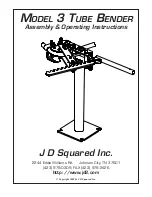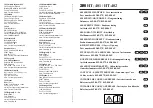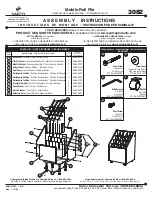
ENGLISH
ORIGINAL INSTRUCTION
4
y
Always wear impact-resistant eye protection during operation of the tool. The grade of protection required should
be assessed for each use.
y
The risks to others should also be assessed at this time.
y
Ensure that the workpiece is securely fi xed.
y
Check that the means of protection from ejection of fastener and/or mandrel is in place and is operative.
y
Warn against the possible forcible ejection of mandrels from the front of the tool.
y
DO NOT operate a tool that is directed towards any person(s).
1.3 OPERATING
HAZARDS
y
Use of the tool can expose the operator’s hands to hazards, including crushing, impacts, cuts and abrasions and
heat. Wear suitable gloves to protect hands.
y
Operators and maintenance personnel shall be physically able to handle the bulk, weight, and power of the tool.
y
Hold the tool correctly; be ready to counteract normal or sudden movements and have both hands available.
y
Keep tool handles dry, clean, and free from oil and grease.
y
Maintain a balanced body position and secure footing when operating the tool.
y
Release the start-and-stop device in the case of an interruption of the hydraulic supply.
y
Use only lubricants recommended by the manufacturer.
y
Contact with hydraulic fl uid should be avoided. To minimise the possibility of rashes, care should be taken to wash
thoroughly if contact occurs.
y
Material Safety Data Sheets for all hydraulic oils and lubricants is available on request from your tool supplier.
y
Avoid unsuitable postures as it is likely for these positions not to allow counteracting of normal or unexpected
movement of the tool.
y
If the tool is fi xed to a suspension device, make sure that the fi xation is secure.
y
Beware of the risk of crushing or pinching if nose equipment is not fi tted.
y
DO NOT operate tool with the nose casing removed.
y
Adequate clearance is required for the tool operator’s hands before proceeding.
y
When carrying the tool from place to place keep hands away from the trigger to avoid inadvertent activation.
y
DO NOT abuse the tool by dropping or using it as a hammer.
y
Care should be taken to ensure that spent mandrels do not create a hazard.
1.4 REPETITIVE MOTIONS HAZARDS
y
When using the tool, the operator can experience discomfort in the hands, arms, shoulders, neck or other parts of
the body.
y
While using the tool, the operator should adopt a comfortable posture whilst maintaining a secure footing and avo-
iding awkward or off -balance postures. The operator should change posture during extended tasks; this can help
avoid discomfort and fatigue.
y
If the operator experiences symptoms such as persistent or recurring discomfort, pain, throbbing, aching, tingling,
numbness, burning sensations or stiff ness, these warning signs should not be ignored. The operator should tell the
employer and consult a qualifi ed health professional.
1.5 ACCESSORY
HAZARDS
y
Disconnect the tool from the hydraulic and electrical supply before fi tting or removing the nose assembly or acces-
sory.
y
Use only sizes and types of accessories and consumables that are recommended by the manufacturer of the tool;
do not use other types or sizes of accessories or consumables.
1.6 WORKPLACE
HAZARDS
y
Slips, trips and falls are major causes of workplace injury. Be aware of slippery surfaces caused by use of the tool and
also of trip hazards caused by the air line or hydraulic hose.
y
Proceed with care in unfamiliar surroundings. There can be hidden hazards, such as electricity or other utility lines.
y
The tool is not intended for use in potentially explosive atmospheres and is not insulated against contact with
electric power.
y
Ensure that there are no electrical cables, gas pipes, etc., which can cause a hazard if damaged by use of the tool.
y
Dress properly. Do not wear loose clothing or jewellery. Keep your hair, clothing and gloves away from moving
parts. Loose clothes, jewellery or long hair can be caught in moving parts.
y
Care should be taken to ensure that spent mandrels do not create a hazard
.
Содержание AV 5
Страница 19: ...ENGLISH ORIGINAL INSTRUCTION 18 ...
Страница 45: ...FRANÇAIS TRADUCTION DE LA NOTICE ORIGINALE 18 ...
Страница 71: ...DEUTSCH ÜBERSETZUNG DER ORIGINALANLEITUNG 18 ...
Страница 97: ...ITALIANO TRADUZIONE ISTRUZIONI ORIGINALI 18 ...
Страница 123: ...POLSKI TŁUMACZENIE ORYGINAŁU INSTRUKCJI 18 ...
Страница 149: ...ESPAÑOL TRADUCCIÓN DE LAS INSTRUCCIONES ORIGINALES 18 ...
Страница 175: ...NEDERLANDS VERTALING VAN DE ORIGINELE HANDLEIDING 18 ...
Страница 201: ...DANSK OVERSÆTTELSE FRA ORIGINAL VEJLEDNING 18 ...
Страница 227: ...SUOMI ALKUPERÄISTEN OHJEIDEN KÄÄNNÖS 18 ...
Страница 253: ...NORSK OVERSETTELSE FRA ORIGINALE INSTRUKSJONER 18 ...
Страница 279: ...SVENSKA ÖVERSÄTTNING AV ORIGINALBRUKSANVISNINGEN 18 ...
Страница 305: ...PORTUGUÊS TRADUÇÃO BASEADA NAS TRADUÇÕES ORIGINAIS 18 ...






































